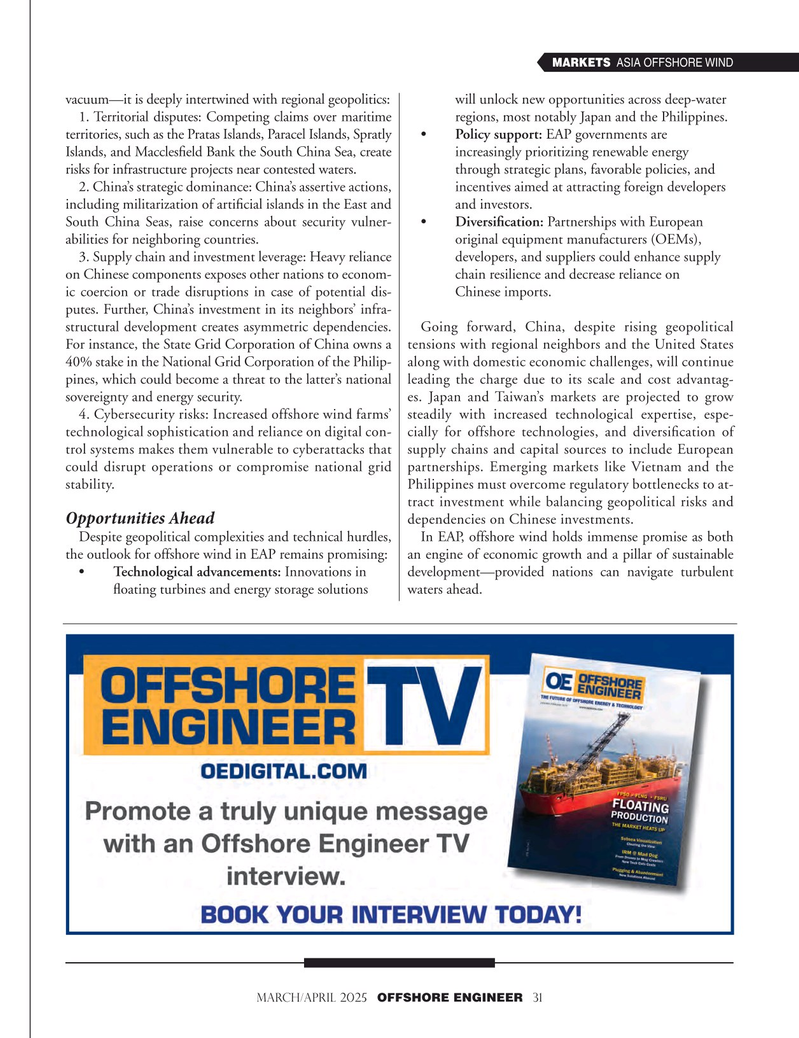
Page 31: of Offshore Engineer Magazine (Mar/Apr 2025)
Read this page in Pdf, Flash or Html5 edition of Mar/Apr 2025 Offshore Engineer Magazine
MARKETS ASIA OFFSHORE WIND vacuum—it is deeply intertwined with regional geopolitics: will unlock new opportunities across deep-water 1. Territorial disputes: Competing claims over maritime r egions, most notably Japan and the Philippines.
territories, such as the Pratas Islands, Paracel Islands, Spratly • Policy support: EAP governments are
Islands, and Macclesfeld Bank the South China Sea, create incr easingly prioritizing renewable energy risks for infrastructure projects near contested waters. thr ough strategic plans, favorable policies, and 2. China’s strategic dominance: China’s assertive actions, incentives aimed at attracting foreign developers including militarization of artifcial islands in the East and and investors.
South China Seas, raise concerns about security vulner- • Diversifcation: Partnerships with European abilities for neighboring countries. original equipment manufacturers (OEMs), 3. Supply chain and investment leverage: Heavy reliance dev elopers, and suppliers could enhance supply on Chinese components exposes other nations to econom- chain resilience and decrease reliance on ic coercion or trade disruptions in case of potential dis- Chinese imports.
putes. Further, China’s investment in its neighbors’ infra- structural development creates asymmetric dependencies. Going forward, China, despite rising geopolitical
For instance, the State Grid Corporation of China owns a tensions with regional neighbors and the United States 40% stake in the National Grid Corporation of the Philip- along with domestic economic challenges, will continue pines, which could become a threat to the latter’s national leading the charge due to its scale and cost advantag- sovereignty and energy security. es. Japan and Taiwan’s markets are projected to grow 4. Cybersecurity risks: Increased offshore wind farms’ steadily with increased technological expertise, espe- technological sophistication and reliance on digital con- cially for offshore technologies, and diversifcation of trol systems makes them vulnerable to cyberattacks that supply chains and capital sources to include European could disrupt operations or compromise national grid partnerships. Emerging markets like Vietnam and the stability. Philippines must overcome regulatory bottlenecks to at- tract investment while balancing geopolitical risks and
Opportunities Ahead dependencies on Chinese investments.
Despite geopolitical complexities and technical hurdles, In EAP, offshore wind holds immense promise as both the outlook for offshore wind in EAP remains promising: an engine of economic growth and a pillar of sustainable • Technological advancements: Innovations in development—provided nations can navigate turbulent foating turbines and energy storage solutions waters ahead.
march/april 2025 OFFSHORE ENGINEER 31

 30
30

 32
32